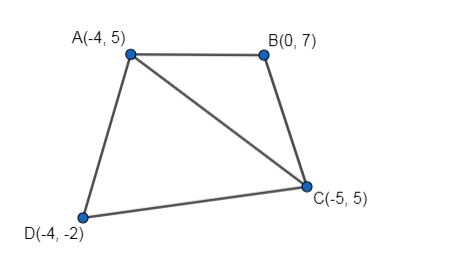Find the area of the quadrilateral whose vertices are A(-4, 5), B(0, 7), C(5, -5) and D(-4, -2).
Given: The vertices of the quadrilateral are A(-4, 5), B(0, 7), C(5, -5) and D(-4, -2).
Formula: Area of a triangle $=\frac{1}{2}\left[\mathrm{x}_{1}\left(\mathrm{y}_{2}-\mathrm{y}_{3}\right)+\mathrm{x}_{2}\left(\mathrm{y}_{3}-\mathrm{y}_{1}\right)+\mathrm{x}_{3}\left(\mathrm{y}_{1}-\mathrm{y}_{2}\right)\right]$

Area of quadrilateral ABCD = Area of Δ ABC + Area of Δ ADC
$=\frac{1}{2}[-4(7+5)+0+5(5-7)]$
$=\frac{1}{2}[-48-10]$
$=-29$
Taking modulus ( $\because$ area is always positive),
Area of $\triangle \mathrm{ABC}=29 \mathrm{sq} .$ units..........(1)
Area of $\triangle A D C=\frac{1}{2}[-4(-2+5)+-4(-5-5)+5(5+2)]$
$=\frac{1}{2}[-12+40+35]$
$=31.5$ sq. units.........(2)
From 1 and 2,
Area of quadrilateral ABCD = 29 + 31.5
= 60.5 square units
Therefore, the area of quadrilateral ABCD is 60.5 square units
Click here to get exam-ready with eSaral
For making your preparation journey smoother of JEE, NEET and Class 8 to 10, grab our app now.
